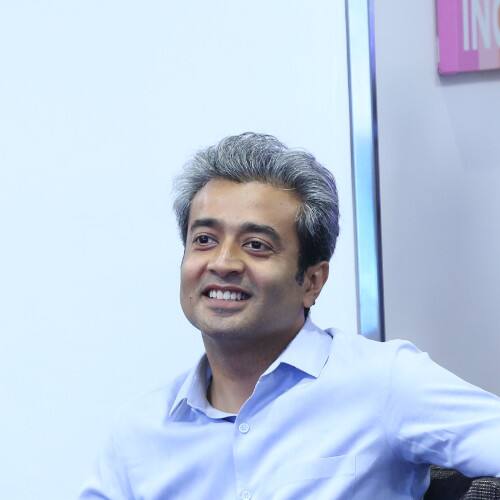Talking to FE BFSI, Anubrata Biswas, MD and CEO of Airtel Payments Bank, discusses how the bank is preparing for a public listing by 2027 and what sustainability within current regulations looks like.

Biswas shares his views on the opportunity in the SFB segment and what regulatory tweaks could unlock better viability. (Source: linkedin)
Airtel Payments Bank is among the few players in the payments bank space to have achieved profitability and scale. But challenges remain. The regulatory framework that governs payments banks continues to restrict key levers of growth. While the bank has found growth in urban transit-linked use cases and rural distribution networks, the long-term viability and operational flexibility of the payments bank model remain among key areas to be addressed.
Talking to FE BFSI, Anubrata Biswas, Managing Director and CEO of Airtel Payments Bank, discusses how the bank is preparing for a public listing by 2027 and what sustainability within current regulations looks like. Biswas also shares his views on the opportunity in the small finance bank (SFB) segment, what regulatory tweaks could unlock better viability, along with an inside view of what’s working and what isn’t in a format that remains under pressure despite initial promise.
You are planning to go public soon. How are the plans progressing?
I would say it is a straightforward matter. On September 24 last fiscal our net worth crossed Rs 500 crore. The regulatory mandate is that we need to list in three years from when our net worth crossed Rs 500 crore. The outer end of going IPO would be September 2027. So, in the next three years we would expect to see ourselves as a significantly large public company.
For that, we would certainly need to be well prepared. The bank was at around Rs 2,700 crore of revenue in FY25. We have been profitable for three years, with an EBITDA of around Rs 300 crore. Our compound annual growth rate (CAGR) across financial metrics is in very high double digits, averaging over 40 per cent. We’ve got monthly transacting users across all businesses of over 100 million, and an annualized GMV of over Rs 4 lakh crore. It’s by no means insubstantial in impact and is irrespective of going public.
What about your average revenue per user (ARPU) growth and cost?
Our ARPU (average revenue per user) is Rs 25 per month, and our cost is Rs 21–22. The ARPU has steadily increased over the last 36 months, while costs have remained steady. That’s the benefit of scale. I’m confident ARPU will keep rising, the user base will grow, and costs will remain marginal. So, sustainability is important. However, for an industry to be thriving, it needs to have certain tenets -- capital should keep flowing in, competition must stay healthy, and new players should enter the space.
How has the payments bank space evolved in the past few years in the Indian banking sector?
What we feel excited about, which has nothing to do with the IPO, is what has happened to the narrative around consumers. What has happened in the last few years is that post-UPI, post-Aadhaar, post-eKYC and so on, it’s become relatively easier to do digital payments. Broadly, between 2020 and 2023 was the phase when payments got unbundled in India and hence today 90 per cent of payments are happening outside traditional banks.
What we are seeing today is that the second bank account is getting unbundled from the primary banks. This is happening in rural India, where people want a bank account close to their village, and in urban India, where people are choosing a second bank account for various needs, including safer digital payments. So what has happened is that payment banks, and in particular Airtel Payments Bank, have become the preferred second bank account destination for people.
We are now opening close to a million accounts a month, nearly half from urban India and a majority are opened digitally. 77 per cent of customers say they want a second account for safety in digital payments. They don’t want their primary bank accounts exposed to fraud or cluttered statements. This shift has pushed the payments banks category into mainstream banking and is now at the forefront of digital banking.
If you look at RBI’s mobile banking user statistics, SBI has the largest mobile banking user base, followed by HDFC Bank, and third is Airtel Payments Bank. That shows how quickly this mobile-only, digital-first bank has been adopted. That’s what excites us internally with the landscape just getting started.
Payments banks operate under tight regulatory boundaries with profitability constraints. What regulatory relaxations do you seek to improve viability?
Let me split my response into three parts. First, a constraint in some ways is an opportunity for payments banks. For instance, the Rs 2 lakh per customer deposit limit is often perceived by customers as a safety barrier to keep their money protected up to that limit. So, it helps in the perception of a secure second account.
Second, there are two kinds of players in the payments bank space—those who have scaled and those who haven’t. Scale is when you reach around 50 million users. That’s when profitability kicks in with your fixed costs spread across a large base and your revenue per user crosses your cost per user. If you look at the profitable payment banks in India today, they’ve all reached that point of sustainability.
This brings me to the third part of the answer. Payments banks today serve over 200 million monthly users across remittances, Aadhaar Enabled Payment System (AEPS), bank accounts, and more. The argument is that these customers would be better served if certain product limits like deposit caps were relaxed. The path to that could potentially be by allowing payments banks to become small finance banks or by permitting them to offer small-ticket loans. While the final call lies with regulators, we hope one or both of these options will be considered favourably.
Would you look at a small finance bank (SFB) status?
Currently, that route is not possible for us as we are a corporate house-owned payments bank. The SFB route today is possible for a non-corporate house-owned payments bank. It would be a strategic choice for a company’s board. For us at the moment, it's not possible. We would await regulatory consideration and clearance around it.
But lending is scalable?
Lending, in terms of the consumer base, is a very big opportunity. But the way it’s allowed currently, through distribution partnerships, is not very scalable. We can’t fully own the consumer journey, so it tends to be broken. And given our strong customer focus, we’ve seen that broken journeys don’t result in good conversions. Our logic has always been to ensure better consumer journeys. That’s why we believe owning the full lending journey is better, and why our argument to the regulator has always been to allow full-scale lending.
What traction have you seen in the National Common Mobility Card (NCMC) category? How does that drive your payments bank business?
At Airtel Payments Bank, among the routes we take to reach consumers are the safe second account and the urban metro route. Today, we are the largest metro acquirer in the country, with roughly two-thirds of all metro tap-and-pay transactions processed by us. So, if someone taps a card in the Delhi Metro, that transaction is likely processed by us. If they’re purchasing an NCMC card there, that card is likely ours too. We have around 60 per cent market share in that category.
Once consumers purchase the card, they tend to come onto our mobile app over a period of time and eventually upgrade to a full bank account. So, it becomes another entry point into digital banking for the urban consumer, which is central to our thesis. In urban India, we’re placing two big bets: one, that people will adopt second accounts primarily for safety; and two, that they’ll use digital bank accounts for transportation needs —NCMC, FASTag, and more. In both categories, we are the largest player.
We aim to reach 10 million NCMC cards in the next two years. We’re already at 1.5 million. That’s a significant scale. And we believe the safe second account market itself is a 100 million user opportunity.
On the rural side, how has business grown and its impact on women?
Rural was actually our first business, started around six years ago. I personally spent a lot of time identifying what we called white spaces—untapped areas in deep rural India without branches or ATMs. India has half a million villages with populations under 2,000. According to RBI, these are served by 3.5 lakh business correspondents, and more than 2.5 lakh of them are with Airtel Payments Bank. So, we’re clearly dominant in that space.
As a result, we are able to see deep social transformation in rural India. We now have close to half a million business correspondents active every month—1 lakh of them are women, up from 50,000 just 18 months ago. Around 33 per cent of the accounts opened are by women, double from what it was two years ago. Many of these are women who bought their first smartphone in the last 18 months and are choosing to open accounts in their own name—it's an expression of identity. This is a different model—soft cash deposit, withdrawal, and remittance—not product-market led. And it’s tightly linked to account growth.
Similar to many fintechs and corporates, are you looking at the super app model?
We will do what is allowed under the Banking Regulation Act. At the end of the day, we are a bank. We can't do something which we can't aspire for. Having said that, a lot of banks are bundling non-banking services and offering them in plans. So, we will do whatever we can, but we will stay brutally focused on what the customer needs as opposed to making things confusing for him.
By continuing you agree to our Privacy Policy & Terms & Conditions
